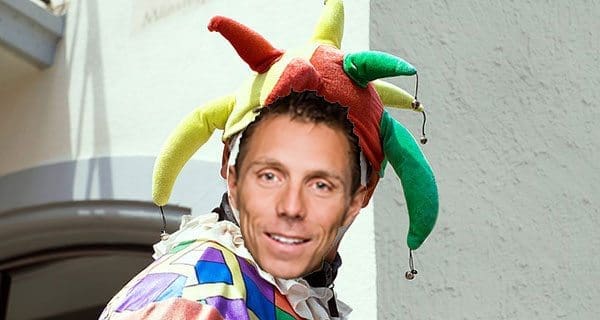 The Patrick Clown Show continues to be the biggest political story in Canada – but the biggest provincial conservative party, the Ontario PCs, are still competitive.
The Patrick Clown Show continues to be the biggest political story in Canada – but the biggest provincial conservative party, the Ontario PCs, are still competitive.
How come?
The papers are brimming with stories about Patrick Brown. For instance: on Wednesday morning of last week, out of 13 provincial-politics-related clippings landing on staffers’ desks at Queen’s Park, fully 12 were about the man who wants to lead a Progressive Conservative caucus that wants nothing to do with him.
There was a news story about Brown dating an intern in his office – and then taking her on international trips, paid for by God knows who.
There was a news story about Brown scheming to sell off some Aeroplan points and a minuscule share in a bar for a whopping $375,000 to a pal – and then said pal somehow thereafter winning a coveted Progressive Conservative nomination, uncontested.
You’d think that all that controversy would be taking a toll on Ontario Progressive Conservative fortunes, right? But you’d be wrong. Here’s the evidence:
Ipsos: Notwithstanding the Patrick Clown Show, nearly 40 percent of Ontarians still plan to vote PC – with the Liberals and NDP effectively tied, at 29 and 26 percent respectively. Said Ipsos spokesperson Darrell Bricker: “If [the PCs] are leading by that much, they’re poised to form a majority government.”
Forum: Despite all the Brown-related follies, almost 50 percent of Ontario voters say they support the PCs – with the Liberals getting less than half that, at 24 percent, and the NDP 19 percent. Said Forum boss Lorne Bozinoff: “The premier doesn’t seem to connect with the electorate. … The constant stream of media attention and fervour surrounding the leadership race has done nothing but help the Progressive Conservatives.”
Campaign Research: Campaign Research (who my firm uses, full disclosure) had the Kathleeen Wynne-helmed Liberals competitive with the Brown-led PCs for months. As soon as the PC caucus dumped their leader, their party rocketed ahead – with 43 percent support, and the Liberals and NDP rounding out the bottom at 28 and 20 percent, respectively. Said Campaign Research chief executive officer Eli Yufest: “When you’ve got the stark contrast between Patrick Brown and Kathleen Wynne, people were on the fence – or at least tied between the two leaders. Now that people have been given more options – namely Doug Ford, Caroline Mulroney, and Christine Elliott – they’re giving the PCs a more serious second look.”
Welcome to the Donald Trump polling era, wherein a party’s brand can be linked to sex, corruption and appalling behaviour and still be way ahead. Way, way ahead.
So what accounts for it? No less than three much-cited polling firms confidently predict that the Ontario PCs will win a majority if they pick Elliott, Mulroney or Ford (with Elliott providing the biggest electoral payoff). How can this be?
Two reasons. (And neither have to do with corruption or scandal. Scandal suppresses voters, sometimes. But it doesn’t motivate voters.)
• Change versus more of the same.
That was the ballot question in 2003, when Liberal Dalton McGuinty scored a massive majority win – and helped to elect a newcomer named Kathleen Wynne. “Choose change” was the pithily brilliant slogan selected by Don Guy and Laura Miller in 2003 and it worked. Bigly.
It worked a decade before that, too, for Bill Clinton. Those words were affixed to the war room wall in Little Rock, Ark., by the legendary James Carville: “Change versus more of the same.” When that’s the frame for an election, Carville later told me, the challenger will always beat the incumbent. Always.
That, increasingly, is the frame in Ontario. That’s what the aforementioned polls clearly say, too.
• Alternation.
This theory holds that Ontario voters prefer to have different teams occupying the government benches in Toronto and Ottawa. So when the wonderful Liberal Pierre Trudeau ruled the roost in Ottawa, Progressive Conservative Bill Davis dominated in Toronto. In the glorious, great Jean Chretien federal years, the NDP’s Bob Rae and the PC’s Mike Harris and Ernie Eves dominated the Ontario provincial scene. And shortly after Liberal McGuinty commenced his near-decade-long hold on power, Conservative Stephen Harper started his near-decade-long hold on power in Ottawa.
Some pundits and prognosticators dispute the Kinsellian Alternation Theorem, but none of them know what they’re talking about, as usual. The minute Justin Trudeau’s Liberals scored a huge win federal in 2015, Wynne started to track ever downwards. She is now (and has been for some time) the least popular premier in Canada.
Whether it’s alternation or choosing change, one thing can’t be disputed: the 2018 Ontario election must occur by June 7.
And the Patrick Clown Show notwithstanding, the Ontario PCs are still the ones favoured to win it.
Warren Kinsella is a Canadian journalist, political adviser and commentator. His latest book, Recipe For Hate, has just been published across North America and Europe by Dundurn Press.
The views, opinions and positions expressed by columnists and contributors are the author’s alone. They do not inherently or expressly reflect the views, opinions and/or positions of our publication.


